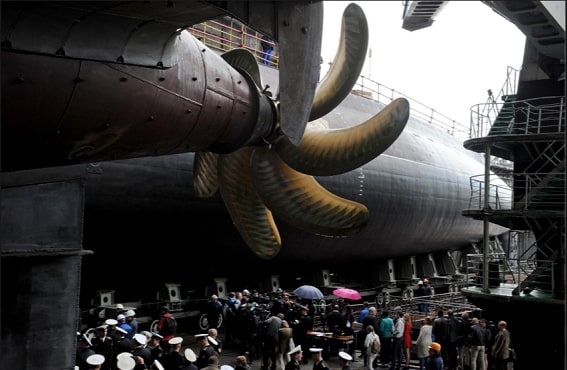
The Kalibr sea-launched cruise missile salvo from the Rostov-on-Don submarine on targets of the Islamic State
Russian Defense Ministry’s press service/TASS
MOSCOW, December 9. /TASS/. The Kalibr sea-launched cruise missile salvo from the Rostov-on-Don submarine on targets of the Islamic State terrorist group in Syria has proven the effectiveness of this complex, Russian Defense Ministry spokesman Igor Konashenkov said on Wednesday.
“For the first time an underwater salvo launch of the sea-based Kalibr missiles has been made by the Rostov-on-Don submarine from the Mediterranean Sea. The recent launch was carried out from submerged position from the submarine’s torpedo tubes,” he said.
Konashenkov said that a massive missile and air strike on the Islamic State infrastructure was delivered on Tuesday with the use of high-precision weapons. The Kalibr sea-based cruise missiles and KAB-500 guided aerial bombs were used in the attack to destroy the terrorists’ vital facilities.
“The available objective monitoring data have once again confirmed high efficiency of the Kalibr missile. All the targets were hit with high accuracy. It should be reminded that the range of the Kalibr cruise missiles is about 2,000 kilometers,” the defence spokesman said.
According to him, missiles of this type have a low radar signature and by means of low-level terrain following they are virtually invisible to any means of air defence.
“The target hitting accuracy, despite the missile’s long range, is just a few metres. Taking into account that the warhead mass is 500 kilograms, the target is destroyed for sure,” Konashenkov said.
He also said that the missile may be equipped both with conventional and special — nuclear warheads. Konashenkov said that in November, the Russian forces used, in addition to Kalibr, the latest Kh-101 air-launched cruise missiles that are capable of reliably destroying targets at a distance of about 4,500 kilometers.
Kh-101 is also virtually invisible to any air defence systems and can be equipped with both conventional and special nuclear warheads. The hitting accuracy of these cruise missiles is within a few metres.
“The Kalibr cruise missile has again proven its effectiveness at long range. We are certain that substantial damage has been inflicted on ammunition dumps, a landmine factory and, naturally, the oil infrastructure,” Russian Defense Minister Sergei Shoigu told President Vladimir Putin on Tuesday.
Ships with the Russian Navy’s Caspian Flotilla fired off 3M-14 submarine-launched cruise missiles (SLCM) on IS’s infrastructure in Syria on October 7 and November 20. The Caspian-based ships launched a total of 44 missiles – 26 on October 7 and 18 on November 20. Obviously, the targets engaged by the Kalibr missiles could have been wiped out by the Russian air task force deployed in Hmeimim air base in Syria’s Latakia province. Thus, it is probable enough that the operation against the extremist groups in Syria is running concurrently with the testing of cutting-edge Russian precision-guided munitions in combat.
“Certainly, everything should be analysed — both what takes place on the battlefield and how the weapons work. Both the Kalibr and Kh-101 missile have generally performed well. They are advanced, up-to-date, highly-effective – as we can see – precision-guided weapons that can carry both conventional and special, i.e. nuclear, warheads. Naturally, the latter are not needed in the fight against terrorists and, I hope, will never be,” Putin said.
The Kalibr system is comprised of a family of the 3M-54 (SS-N-30) antiship, 3M-14 (SS-N-27 Sizzler) land-attack and 91R1/RT2 antisubmarine missiles.
The B-237 Rostov-on-Don submarine is the second one in the six-ship Project 636.3 diesel-electric family designed for the Russian Navy. It was laid down in 2011 by the Admiralty Wharves Shipyard (a subsidiary of the United Shipbuilding Corporation) and launched in 2014. The Rostov-on-Don was commissioned for service with the Russian Navy in December 2014.
The Project 636.3 diesel-electric submarines are third-generation boats derived from the Project 636 diesel-electric design. They have a low acoustic signature, a submerged speed of 20 knots, a 45-day self-sustained operation capability, a submerged displacement of about 4,000 tons, and a crew of over 50. The Project 636.3 submarines feature the Kalibr precision-guided missile system with the 3M-54 and 3M-541 antiship and 3M-14 land-attack cruise missiles and upgraded radio electronics.
ATTENTION READERS
We See The World From All Sides and Want YOU To Be Fully InformedIn fact, intentional disinformation is a disgraceful scourge in media today. So to assuage any possible errant incorrect information posted herein, we strongly encourage you to seek corroboration from other non-VT sources before forming an educated opinion.
About VT - Policies & Disclosures - Comment Policy



